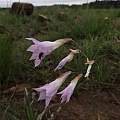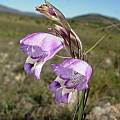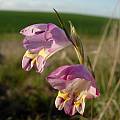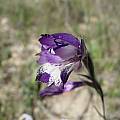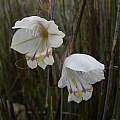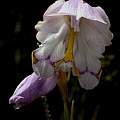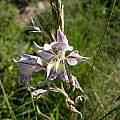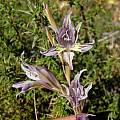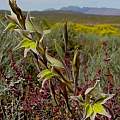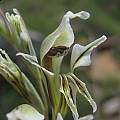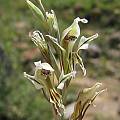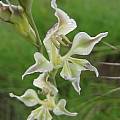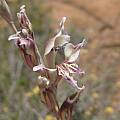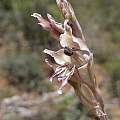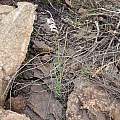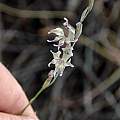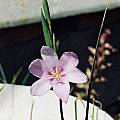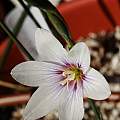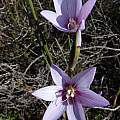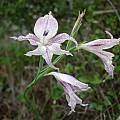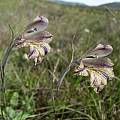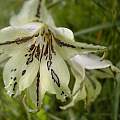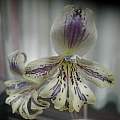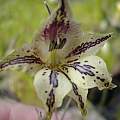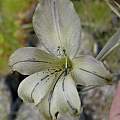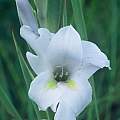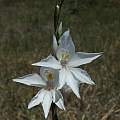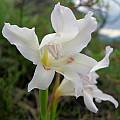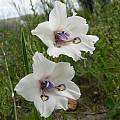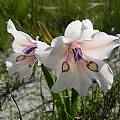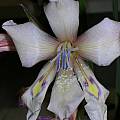These colors are often associated with moth pollination, and so some of the most fragrant Gladiolus can be found in this category. Another big group in this category are those species who have occasionally some kind of albino form - rare in nature, but eagerly adopted by gardeners when found.
Page 1: G. acuminatus... Page 2: G. floribundus... Page 3: G. longicollis... Page 5: G. sekukuniensis...
Gladiolus parvulus Schltr. is restricted to the southern half of KwaZulu-Natal, South Africa, into Lesotho where it grows in thin soil on sandstone pavements or in cracks in sandstone outcrops at elevations up to 3300 m. Growing from 15 to 35 cm, it has two leaves, the larger sheathing the stem and the second a small bract-like leaf immediately below the lowest flower. It has small horizontal to almost nodding light pink flowers with equal tepals. The flowers have been described as looking more like an Ixia or a Dierama. It flowers October to early December. Photo from Rachel Saunders.
Gladiolus patersoniae is widespread in the southern African winter rainfall areas. It occurs in exposed rocky habitats in the interior ranges of the Cape Floral region, but also near the coast at Cape Infanta and on stony alluvial flats near Worcester. It grows on soils derived from sandstone. Plants grow to 50 cm and have narrow cylindrical leaves. The bell like short tubed and sweetly scented (similar to apple and carnation) pale to deep blue, slate, grey or cream flowers are pollinated by long tongued bees. The lower three tepals have a transverse yellow band usually outlined in dark blue or purple. Flowering occurs in late winter to spring, earlier at lower elevations. The first five photos by Cameron McMaster. His last one was taken August 2012 at the top of Potjiesberg Pass south of Uniondale (Eastern Cape) where it was growing with Gladiolus mutabilis. The last photo from the book Plants of the Klein Karoo courtesy of Jan and Anne Lise Schutte-Vlok.
Gladiolus permeabilis D.Delaroche grows on shale slopes in renosterveld from Caledon east through southern Africa and to Zimbabwe. In the Cape province it blooms late winter into spring. Usually 20 to 30 cm tall, but can be up to 50 cm, it has flat narrow leaves with a prominent midrib and mauve to dull purple or cream flowers with yellowish makings. Flowers are usually intensely fragrant. The first photo was taken by Cameron McMaster in the Overberg and the second by Bob Rutemoeller in the Bontebok National Park. The last photo below from the book Plants of the Klein Karoo courtesy of Jan and Anne Lise Schutte-Vlok
Gladiolus permeabilis ssp. edulis (Burch. ex Ker Gawl.) Oberm., syn. Gladiolus edulis, is widespread across the summer-rainfall zone and is common in the drier areas. This subspecies has whitish to cream, sometimes grey or mauve flowers. All of the tepals except for the dorsal have a grey to purple or maroon midline sometimes surrounded by a yellow streak. The lower lateral tepals are yellow in the upper half. Tepals have an elongated and tapering tip or tail-like twisted and undulate appendages. Photos taken by Cameron McMaster in two locations in the Eastern Cape.
The photos below were taken at Andriesberg by Cameron McMaster and Bob Rutemoeller in January and February, different years.
Gladiolus quadrangulus (D.Delaroche) Barnard (syn. Ixia linearis, G. linearis, G. biflorus) is found in the southwestern Cape in sandy soil in seasonally wet, poorly drained and sometimes brackish habitat. Goldblatt & Manning report that it has been eliminated from most of its original range, and that "its long-term survival in the wild is unlikely." Fortunately, it is relatively easy to grow in cultivation, where it can be treated like a typical winter-growing Glad. It has pale pink, mauve or white flowers. The tepals have darker veins. It blooms late winter into spring. The shape of the flowers is reminiscent of an Ixia, and unlike most Gladiolus it does not produce nectar. Goldblatt & Manning speculate that it is adapted to pollination by pollen-eating insects. First photo by Alan Horstmann. Second photo by Michael Mace of a plant whose name tag was lost, but which is almost certainly G. quadrangulus. The final photo was taken by Rachel Saunders who photographed it in the wild.
Gladiolus recurvus Linnaeus occurs in shale derived soils from Ceres to Bredasdorp and flowers from June to October depending on the elevation. The fragrant flowers are pale gray to cream, yellowish or pinkish with purple lines and dots on the lower tepals and sometimes spotted or lined in the midline on the upper tepals as well. The first two photos were taken by Cameron McMaster in the Overberg. The other photos by Dirk Wallace show variation in the markings on flowers.
Gladiolus rehmannii Baker is a summer rainfall species that grows in sandy soils, often in rocky ground in light woodland in the northern part of South Africa to eastern Botswana. Growing from 30 to 50 cm, it has white to pale lilac flowers with yellow nectar guides and is unscented. It blooms from mid January to March. Photo from Rod Saunders.
Gladiolus robertsoniae F.Bolus is a summer rainfall species endemic to a small area in the highveld of southern Mpumalanga and the Free State South Africa where it grows in rocky sites, mostly dolerite outcrops, where corms are wedged in crevices and therefore protected from predators. Sites are restricted to areas that stay wet longer such as seeps or streambanks. Plants grow from 20 to 40 cm high. Plants flower at the end of the dry season (mostly October, but sometimes later). A species of section Hebea, it has large white long tubed flowers with fine red lines at the base of the lower tepals. Flowers are sometimes flushed light mauve on fading and are fragrant, scented of carnation day and night. Photo from Rachel Saunders.
Gladiolus rudis Licht. ex Roem. & Schult. grows on sandstone slopes in fynbos in the southwestern Cape and blooms in spring. It has 2 to 5 cream to pale pink flowers on a spike. The lower tepals have spear-shaped markings and the perianth tube is funnel shaped. The first three photos taken by Cameron McMaster near Caledon and Fairfield in the Overberg and the last taken by Alan Horstmann.
Page 1: G. acuminatus... Page 2: G. floribundus... Page 3: G. longicollis... Page 5: G. sekukuniensis...
